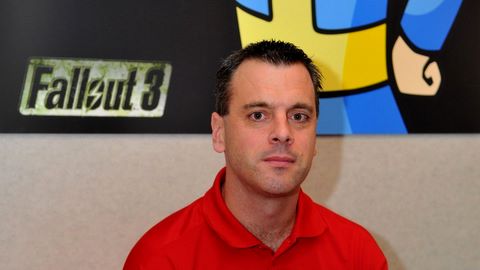Founded in June 2011, Other Worlds Software is a three-man team created by two friends with the dream of making video games. After going through a long list of off-the-wall ideas, they decided that Necromancer would be their first commercial release. In this game, the player becomes the necromancer who has started the zombie apocalypse, and they must stop the heroes from turning the tide and beating the zombie horde! Carl Benjamin, programmer at Other Worlds Software, talks about the creation of the game.
Growing Into Mobile
Back in late 2013, The Other Worlds Software team had just started getting into mobile gaming. We come from the old guard, the PC master race, who are slowly evolving to catch up with the rest of the world. We grew up playing Doom, Quake, Dune 2, Command and Conquer, UFO, and Fallout. Rome: Total War became a staple multiplayer game for us, when we weren’t playing D&D or WH40k, and our weekend gaming sessions would get very competitive.
We were skeptical, but we got some tablets. After using them for awhile, we found we enjoyed them. I am sure it is in no way because it made us feel like we’re in Star Trek.
Suddenly, mobile gaming became the next great step in our gaming lives and made our get-togethers a lot easier - no more lugging desktop PCs and CRT monitors around! The only problem is the lack of really good strategic and tactical games on mobile platforms, especially those with co-operative multiplayer features. So we decided to change that.
Playing as the Zombie
Necromancer began life around six months ago. My girlfriend asked me for a copy of Sims: Supernatural for Christmas, because it had sim zombies in it. I was a bit baffled; what would be the point of being a sim zombie? They don’t eat or sleep or even talk, all they do is eat brains! I was pondering on it, and started to wonder what kind of game would you have if you were going to play as the zombies during the zombie apocalypse?
But we had to leave this idea to simmer on the backburner and turn our hands to larger - and still incomplete - projects, as the Other Worlds Software team all had jobs, families, and responsibilities. We decided to take our time, pace ourselves and work slowly and steadily towards our goal of releasing Drones, a turn-based, double-blind tactical game
Unfortunately, things change and one has to change with them. We carried on working like this for around six months, until the recession cost two of the team their jobs - the lead programmer (me) and the animation director, Russ Jarvis. This left us unemployed and, with the job market as it is, it seemed that circumstances had conspired against us to declare that this is the place and now was the time to make the game we’d been wanting to make for years. Russ, Giuseppe Constantino, and I got to work.
Developing Necromancer
We only started work on Necromancer in December 2013, and it is already nearing completion. Luckily, we’d been working on diverse projects over the years as we honed our skills and we built up a good stockpile of things we’d need for Necromancer, such as scripts, assets, and hardware.
Necromancer‘s mechanics are based on ideas we have been formulating for years, so before I wrote the first line of code, we already knew that we’d have eight different kinds of undead minion, six different spells, and eight heroes to defeat. Our experience of developing larger projects was very valuable at this point - we are dreamers with big dreams, but this time we knew we had to be very strict about the amount of content we could put into Necromancer. Being such a small team, we’ve got to be realistic. Through this, we were able to make our game, with thanks to Dark Anatomy, Yoeri Veer, and Many-Worlds.co.uk for helping with artwork.
The major hurdle was that none of the team had developed a game for mobile devices before. Luckily, our experience was built up using the Unity game engine, which is fantastic for cross-platform development. Porting Necromancer to Android was incredibly smooth and easy, with only the most minor of bumps along the way. It felt like this was going too easily!
The Parts that Make Up Necromancer
Once we had a prototype of the game up and running on Android, it was all systems go on development. AI scripts, 3D assets, and animations went in day by day, with constant playtesting to make sure everything was working as it should. Once we were happy with that, we got down to what, for me, is the most entertaining part: making levels. Even as a teenager, I would spend my evenings creating Doom 2, Quake and Half-Life levels. I don’t know why, but I love it. Initially, we had planned to make procedurally-generated levels for Necromancer, but that idea was phased out in favor of creating levels that presented specific challenges for the player. The procedural levels didn’t look great, and they didn’t allow us to put specific obstacles in the path of the players that made sense. It didn’t fit the style of the game.
The minions the player will command are one of the most important aspects of Necromancer. We love the classic zombie movies - to us, zombies aren’t the fast-running infected, they are the slow, mindless shamblers that come in hordes. They are the living dead that burst their way up from the ground! We also wanted the player to have hordes of them; you can hardly command armies of zombies if you can only raise one at a time, so each time you raise zombies, you raise a mob. You have a ready supply of these, although the number you can raise and control at one time is limited…at first. As each level progresses, you become a more powerful necromancer with more zombies available to you and more can be raised at a time.
We felt that the special undead minions the player controls were the most important. We particularly don’t like it when upgrades are strictly better than what came before - in any game. We prefer to make our games so that each unit or weapon never becomes obsolete, but performs a different function to the next one. We think it gives the player opportunities to calculate their advantages and use their resources to maximum effect, so tactics really make a difference. So far we have revealed the Wight, Mummy, and Liche.
The player will have access to six spells that can dramatically influence the course of a game. The spells are split into two categories, boons and curses. Boons boost your minions in certain ways and the curses hinder the heroes. You only have a limited number of these, that you can collect throughout the level or purchase between each level, so it is important to use them wisely.
Replayability is very important to us. When we’ve found a multiplayer game we all like, we tend to play it a lot. We wanted to make sure any games we make have the same kind of replayability that we value in the games we enjoy. We decided on an efficiency system, by which we track the number of heroes killed and zombies lost, as well as how long it took to complete the level, and calculate the player’s overall efficiency. The players get a trophy depending on how well they do - either bronze, silver, or gold.
Going to Kickstarter
We chose Kickstarter because it has the most lively, vibrant community. We cannot afford to release Necromancer without the help of the good people of Kickstarter, who help make dreams happen. The costs of the commercial licenses for the software are much more than we can afford, and we still need to purchase a lot for the game to be finished - voice acting, terrain models and effects.
As you can imagine, we’re very nervous about doing our first Kickstarter campaign. We’re not in marketing, we’re gamers! We are rubbish about talking about ourselves. Of all the challenges we’ve had to surmount in order to reach this point, writing the Kickstarter and trying to sell ourselves is by far and away the hardest part.
We’re planning to have 50 levels, but if our Kickstarter campaign goes better than expected, we’re certainly going to increase this number. The first three environments of the game (10 levels each) will be open, and any further environments will require a certain number of each trophy to unlock. This means that you’ve really got to focus!
If you like the sound of what Other Worlds is doing, keep updated their Facebook page , their website (which is currently in-development, so they ask that you please be gentle), Twitter, or head straight to their Kickstarter page and take a look.










